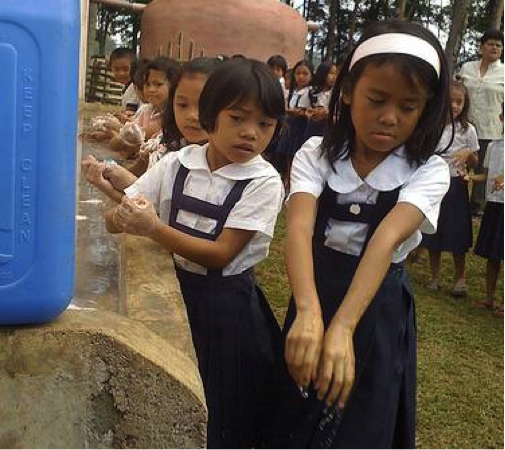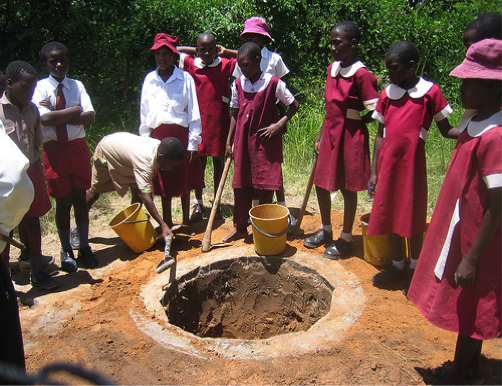Sustainable Sanitation for Schools
Sustainable sanitation is defined as promoting and improving health and hygiene, protecting environmental and natural resources, and being technologically and operationally appropriate, financially and economically viable and socio-culturally and institutionally acceptable (SuSanA, 2008).
Access to safe sanitation is a human right that has to be recognised and fulfilled (Stock, 2011). The major challenge to reach the Millennium Development Goal for improved sanitation (MDG 7) is not merely technical nor economic, but lies in raising awareness on preventable sanitation-related diseases, changing traditional views and encouraging habits for good hygiene (UNICEF/WHO, 2008).
Behaviour is formed during childhood and therefore education on health and hygiene in schools is vital to improving conditions of people’s lives from childhood to adulthood. School sanitation and hygiene programs can have important outreach functions for targeting households. Children have demonstrated that they can be effective agents of change as demonstrated in School-led Total Sanitation programs in Asia, Latin America and Sub-Saharan Africa.
Sanitation issues for urban schools tend to differ somewhat from those at rural schools. For example, urban schools often have less space, but sometimes have the possibility to connect to a centralised sewer system. Some technologies like pit latrines and Arborloos might be feasible for rural schools but not for most urban schools. The involvement of parents and the wider community might also have a different intensity at urban schools. Nevertheless, the same guiding principles apply to school sanitation in all settings.
Contents
Defining the problems

a) Poor access and use of sanitation facilities
It is estimated that approximately two-thirds of primary schools in the developing world do not have adequate sanitation (CARE et al., 2010). Lack of sanitation leading to diarrhoea in children is attributed to 272 million schools days lost each year and to intestinal worm infestation of an estimated 400 million children. Where facilities do exist, as many as 150 children have to share one toilet in some schools. At that ratio, pupils have to queue up to use the facilities; also the toilet pits fill up quickly (in the case of pit latrines) and toilets become smelly making them both unattractive and unhygienic for the pupils to use (Zomerplaag and Mooijman, 2005).
b) Lack of policy framework and institutionalisation of school sanitation
Generally, there is a lack of political frameworks for sanitation and WASH in general at all levels to guide implementation, operation and maintenance. Where sanitation policies do exist, they are often unclear, or even contradictory, in their aims and objectives (Elledge, 2003). There is also a lack of responsibility taken for school sanitation by the school principal or even school inspectorates who do not prioritise the responsibility for proper operation and maintenance of facilities.
c) Lack of budget allocation for operation and maintenance
Public schools, like most public institutions, are generally not oriented towards being particularly economical and cost-effective. This is because of the lack of incentives to do so since they are not fully in charge of their own annual budgets.
There is also a lack of supporting policy environment, therefore finding economically viable solutions or maintaining existing sanitation facilities in a cost-effective manner is unfortunately not a priority for many schools. Muellegger et al. (2012) provides more details on operation and maintenance (O&M) problems and solutions for sustainable sanitation systems in general.
d) Inappropriate designs for children, especially girls, small children and children with disabilities
Sadly, the few toilet facilities present at schools often do not meet children’s needs. Small children are affected in terms of the size of the drop hole in the case of pit latrines, size of squatting pan or pedestal as well as issues of darkness in the toilets which creates fear. Children with disabilities are often excluded altogether by the lack of accessible facilities. Adolescent girls are affected and distressed in terms of privacy, security and menstruation management.
Toilets which are not designed to be “child friendly” may be scary or difficult to use for small children, as in Malawi where children feared falling into the large drop holes of pit latrines or entering the dark facilities with little light or ventilation. The results were that children defecated in the entrance to the latrine and in the corners of the latrine – rendering them filthy and unhygienic to the next user (B. Abraham, personal communication, 2010).
e) Social and cultural norms against dealing with human excreta
Sustainable sanitation solutions with a component of reuse of treated excreta or wastewater are generally perceived to be more complex to operate and maintain than conventional technologies without reuse. On the other hand, they can be utilised to teach children about growing vegetables in school gardens, using compost and fertiliser from “productive” sanitation systems; see Section 5 in this factsheet.
In terms of ecological sanitation (ecosan), which is part of sustainable sanitation, human excreta are regarded as a resource which can be used as a fertiliser in agriculture or to produce biogas. However, for many people, the idea of handling excreta brings a strong feeling of disgust, related to unpleasant past experiences of strong odours, flies and the unsightliness to the immediate environment.
To see these topics expanded upon, look at our Fact Sheet.
Linking sanitation and nutrition
Malnutrition, iron and zinc deficiencies are major nutritional shortfalls from which pre-school and primary school children suffer. This makes a good case for sustainable sanitation linked to school gardens with three main objectives:
- an educational objective to teach children about growing healthy foods;
- a nutritional objective to provide children with healthy food and;
- an economic objective to generate a supplementary income for schools (Drescher, 2002; Morgan and Shangwa, 2010).
One of the advantages with choosing those types of sustainable sanitation technologies which emphasise reuse of treated excreta (such as urine diversion dehydration toilets (UDDTs), Arborloos and Fossa Alternas) is that human waste can be used as fertiliser and soil conditioner after sanitisation (see Richert et al., 2010). Also, the children can be involved during the construction of these toilets.
Sanitised human excreta can be used for nutrient recycling in school gardens, where children can be taught how to grow their own vegetables (see Morgan and Shangwa (2010) for examples in Zimbabwe). Biogas produced from human waste and other organic matter in biogas digesters can be used for cooking in the school kitchen. Treated wastewater can be applied in the school garden for irrigation.
If the local socio-cultural norms do not support the reuse of excreta, additional awareness raising is necessary by demonstrating the nutritional and economic benefits for the schools. Planning needs to be done in collaboration with school staff and adjacent farmers to investigate possibilities for transport and use of urine and treated faecal matter on nearby farms.
Selling vegetables from a school garden which is more productive due to the additional “toilet fertiliser” could give the school a small income, covering for example provision of soap and toilet paper. This incentive may also lead to greater care for the school toilet by users and cleaning staff as the fertiliser production would have a real value for the school.
Guiding principles for sustainable sanitation in schools

General factors for achieving long term success in implementing sustainable school sanitation are:
- Awareness raising among the decision-makers on the importance of school sanitation.
- Stakeholder involvement in decision making and planning, particularly children’s participation and good leadership
- Creating demand through stakeholder involvement by employing demand-driven approaches.
- Monitoring outcomes, impacts and processes, including health and hygiene assessments, school attendance and usage of facilities.
- Using many channels and media for promotion of sanitation and hygiene emphasising also benefits beyond health benefits alone (multi-faceted approach).
- Having an enabling legal, technical, economical and social framework in place for the implementation of new and sustainable sanitation concepts for schools.
a) Children at the centre: Child-friendly facilities
The involvement of children in planning and design of both hardware and software is essential. Without a child-centred approach, the sanitation system may remain unused and unhygienic behaviours may prevail (such as open defecation and no hand washing).
Child-friendly facilities should (more details provided in IRC, 2007):
- Have appropriate dimensions for children to be able to use them correctly and at any time.
- Offer enough capacity and minimise waiting times, otherwise children may resort to open defecation.
- Use appropriate locations for young children considering cultural, environmental and practical aspects which encourage regular use.
- Address gender roles and needs, particularly those of adolescent girls during menstruation.
- Address the needs of children with special needs, particularly those with disabilities.
b) Demand-driven approach
School-led Total Sanitation uses schools as the entry point for total sanitation in communities. This was demonstrated with some positive examples in Nepal, Indonesia, India and Kenya (UNICEF, 2008; Kurniawan, 2008; Otieno, 2008). School children have provided the impetus through self-respect, pride, guilt, shame and disgust to end open defecation in schools and the communities, and have created a demand for sanitation.
c) Multi-facet approach to advocating and promoting sustainable sanitation through skills-based education

Construction of sanitation facilities alone is not enough to make significant impacts on health and livelihoods (World Bank, 2005). Based on the experiences of Community-led Total Sanitation (CLTS), advocating for sanitation purely on health benefits alone is also not enough to elicit change in behaviour and encourage households and pupils to adopt new behaviours (Kar, 2010). A multi-faceted approach which uses different concepts and methodologies to encourage people to assess their situation and find appropriate solutions is essential.
In schools, skills-based hygiene education which includes songs, drawings and daily routines are more likely to reach a wider audience and raise the interest of more children including their parents. One successful example for a skills-based approach in terms of handwashing is the Fit for School program in the Philippines (Benzian et al., 2012). Moreover, building arguments with demonstrated successes based on improved livelihood, increased attendance rates, convenience, economic advantages, environmental improvements, or pride and status, go a lot further to mobilise key decision-makers in schools and communities to support sustainable sanitation.
The overriding element for success is stakeholder involvement and ownership. Beyond a superficial or passive engagement, stakeholders – in particular the pupils, teachers, parents, caretakers and school administration – should ideally be involved in the selection, design and if possible construction of facilities, as well as organisation of management, long-term monitoring and problem solving. Stakeholder involvement and subsequent ownership ensures that local and appropriate solutions are applied, making the sanitation system sustainable.
Costs
Sustainable sanitation in schools does not need to be expensive. A simple, low-cost toilet can meet all the principles of sustainable sanitation (health, hygiene, environment, economical, technologically appropriate and socio-culturally acceptable). However, superstructures made of cheap materials might need to be renovated faster (and re-investment financing is difficult to find again). Investments for school sanitation should focus on the long-term maintenance and operation to ensure sustained use and health benefits for children.
Field Experiences
There are many examples of school sanitation projects and programmes throughout the world from which we can learn important lessons towards improving school sanitation approaches. See, for example, the case studies on the SuSanA website susana.org/case-studies.
Links
| A l'eau les mains! Quand te laver les mains? Comment te les laver? | |
| Affiche: Mesures contre la diarrhée | |
| Affiches de sensibilisation Hygiène et Assainissement de Tessaoua |
Acknowledgements
SuSanA factsheet : To see these topics expanded upon, look at our Sustainable sanitation for schools, July 2011. The Fact Sheet also contains a full list of references.



